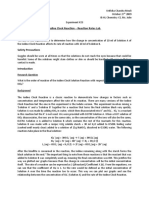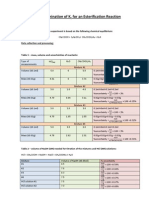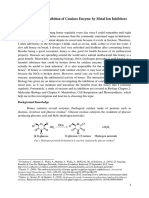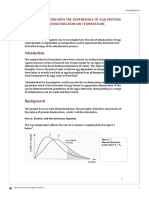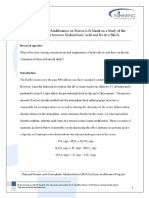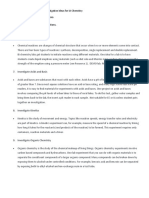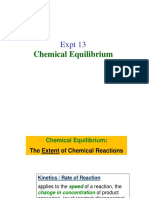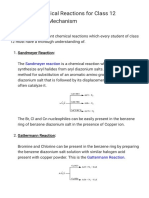IB Chemistry IA Hess's Law
IB Chemistry IA Hess's Law
Uploaded by
Jason J. LnCopyright:
Available Formats
IB Chemistry IA Hess's Law
IB Chemistry IA Hess's Law
Uploaded by
Jason J. LnCopyright
Available Formats
Share this document
Did you find this document useful?
Is this content inappropriate?
Copyright:
Available Formats
IB Chemistry IA Hess's Law
IB Chemistry IA Hess's Law
Uploaded by
Jason J. LnCopyright:
Available Formats
Jason Lin 12F
IB Chemistry IA Hesss Law
Aim: It is difficult to determine the enthalpy change of this reaction directly. To determine the enthalpy change indirectly the reaction of potassium hydrogen carbonate with hydrochloric acid can be compared with the reaction of potassium carbonate with hydrochloric acid. Raw Data: Trial 1 Substance Mass/g
0.05
Trial 2 Temperature Mass/g rise/ C 0.5 0.05 +6.5 - 8.2 2.87 3.40
Average Temperature Mass/g rise/ C 0.5 0.05 +6.1 - 7.7 2.79 3.50 Temperature rise/ C 0.05 +6.3 -8.0
Potassium car- 2.70 bonate Potassium hy- 3.60 drogen carbonate
According to Hesss law, the total enthalpy is the same doesnt matter the pathway a reaction takes. Therefore, by arranging the two reactions (Potassium carbonate + HCl & Potassium hydrogen carbonate + HCl) in triangle, we can K2CO3 + CO2 + get a sort of vector diagram that gives a pathway from potassium hydrogen 2KHCO3 H2O carbonate to potassium carbonate. This is illustrated below: +2HCl 2KCl + 2CO2 +2H2O +2HCl
To calculate the overall enthalpy evolved, we calculate the enthalpy of the two separate reactions first, and we do this by using the formula (Q = mcT)/number of moles, where m is the mass of the solution, in this case the solution used is hydrochloric acid and it is assumed to have the same density as water hence 30ml of it weighs 30g; c is the specific heat capacity of the solution and is assumed at the same value for water as well, at 4.18 ; T is the temperature change after the reaction, I will take the average.
Jason Lin 12F
Calculations: Q of Potassium carbonate + hydrochloric acid: 30*4.18*6.3 = 790.02J Number of moles of K2CO3: 2.79/(39.098*2+12.011+16*3) = 0.0202M Enthalpy change of reaction per mole: H1 = 790.02/0.0202 39110J 39kJ mol-1 Uncertainty: (0.05/30) + (0.05/2.79) + (0.5/6.3) = 0.1% + 1.8% + 8.0% = 9.9% 9.9%*39 = 3.9 4
Q of Potassium hydrogen carbonate + HCl: 30*4.18*-8 = -1003.2J Number of moles of KHCO3: 3.50/(39.098+1.0079+12.011+16*3) = 0.035M Enthalpy change of reaction per mole: H2 = -1003.2/0.035 -28663J -29kJ mol-1 Uncertainty: (0.05/30) + (0.05/3.50) + (0.5/8) = 0.1% + 1.4% + 6.3% = 7.8% 7.8%*29 = 2.262 2 Total uncertainty: 2*2 + 4 = 8 Total Enthalpy evolved = H = 2* H2 + H1 = 29*2 + 39 = 978kJ mol-1 Literature value: H = 92kJ mol-1
Conclusion: By comparing the calculated enthalpy per mole to the literature value for the thermal decomposition of potassium hydrogen carbonate, we see the difference is in fact very small, only +5, showing my experiment to be rather successful and the results to be accurate. The discrepancies of my calculated enthalpy to the literature value could be resulted from the fact that I assumed many properties of the solution to be the same as water, as well as the loss of heat to surroundings. The decomposition of potassium carbonate is endothermic: the more limiting agent I have (potassium carbonate), the most temperature decrease is ob-
Jason Lin 12F tained, this is also shown its the positive H value. It is the opposite for the decomposition of potassium hydrogen carbonate, and the relationship between the IV and DV is the fact that the more mass of potassium hydrogen carbonate is added to the acid, the higher temperature increase. Overall the enthalpy evolved for the decomposition of potassium hydrogen carbonate into potassium carbonate indirectly is exothermic, hence we are told in the research question thermal decomposition of potassium hydrogen carbonate. Evaluation: The percentage error of the actual value to the literature value is (97-92)/92 0.05 = 5% I wouldnt be using error bars however, as a graph is not drawn. However we can see the results are very reliable and accurate because the total uncertainty propagated is 8kJ mol-1 and the value 92 is in the range of 978kJ mol-1. Or it can be expressed in percentage, 97kJ mol-18% The followings are reasons that contribute to the uncertainty: Weakness Assumption of the properties of HCl same as water (systematic) Significance Quite and most significant amongst the rest, because this directly effects the value of enthalpy. Slightly because the mass of the limiting reagent added is very small relative to the acid. slightly because again its amount is relatively small. Improvement Find out the specific heat capacity and density of 2mol dm-3 hydrochloric acid. Include the mass of all reactants when performing calculations.
Assumption of only the solution to be the mass (systematic)
Errors from equipment fluctuation of digital balance (systematic) & human error of reading off thermometer and measuring devices (random)
Use measuring cylinders and balance with even smaller scales and if possible try to use digital measuring devices that dont fluctuate. Use a bomb calorimeter which is a close system where heat cannot escape.
Heat loss to the environ- Quite, heat dissipation ment (random) is easily done and constantly spreading without our knowledge.
Jason Lin 12F
Weakness
Significance
Improvement Plot a graph of the reaction and extrapolate from the constant rate of decrease of temperature later to find out what the initial increased temperature should be. repeat the experiment 5 times or more
Not all heat produced by slightly, this lowers the the reaction is instantly maximum temperature read off by thermomerecorded. ter. (random)
Only performing the experiment twice (random) range of data (random)
generates random human errors- hence imprecise
this effects the precision Best to test with 10 difof the results, as only 2 ferent value of mass (IV) IVs were done. and average the results.
You might also like
- Biology IA FinalDocument12 pagesBiology IA FinalAndrea ClavijoNo ratings yet
- IB Chemistry IADocument12 pagesIB Chemistry IAEmily Sun100% (1)
- Chemistry IA Example 2Document12 pagesChemistry IA Example 2Vanessa Tumanggor100% (1)
- IB Chemistry IA: EnergeticsDocument10 pagesIB Chemistry IA: EnergeticsMomina Amjad88% (56)
- Iodine Clock Reaction IADocument11 pagesIodine Clock Reaction IAKrithika Chandra Mouli100% (1)
- IB Chemistry HL Internal AssessmentDocument14 pagesIB Chemistry HL Internal AssessmentZinzan Gurney100% (2)
- Ib Chemistry Answers r1Document13 pagesIb Chemistry Answers r1Gian Paolo GerzonNo ratings yet
- IBHL Investigations: Investigating Acids Aim: Claudia Braganza IBHL Chemistry Grade 12Document13 pagesIBHL Investigations: Investigating Acids Aim: Claudia Braganza IBHL Chemistry Grade 12tennisrox94100% (1)
- Chemistry IA FinalDocument10 pagesChemistry IA FinalDhiman RoyNo ratings yet
- Chemistry HL IADocument12 pagesChemistry HL IALeena SaikumarNo ratings yet
- IB Biology IA: Enzymes and InhibitionDocument16 pagesIB Biology IA: Enzymes and InhibitionMomina Amjad95% (73)
- Determination of KC For An Esterification Reaction ReportDocument5 pagesDetermination of KC For An Esterification Reaction ReportTuo Hundou Lee100% (3)
- Ib Chem IaDocument9 pagesIb Chem IaFrank Lala0% (1)
- Biology IADocument16 pagesBiology IAAngelina TomacNo ratings yet
- IA - Enthalpy of Displacement ReactionDocument5 pagesIA - Enthalpy of Displacement Reaction14nganhc1No ratings yet
- Chemistry Ia SampleDocument15 pagesChemistry Ia SampleDanisa Irianto100% (2)
- IB CHEMISTRY Toothpaste Experiment IADocument14 pagesIB CHEMISTRY Toothpaste Experiment IASri Vishnu Prabhakar33% (3)
- IB Chemistry IA ChecklistDocument7 pagesIB Chemistry IA ChecklistOGswaggerNo ratings yet
- IB Chemistry 1 SL QuestionsDocument36 pagesIB Chemistry 1 SL QuestionsCamilla0% (3)
- Extended Essay Chemistry New Version 2Document40 pagesExtended Essay Chemistry New Version 2api-245190275100% (12)
- HL Biology IA 20/24Document14 pagesHL Biology IA 20/24dev0% (2)
- IB Chemistry Internal Assessment 1Document13 pagesIB Chemistry Internal Assessment 1beslisevval100% (1)
- Heat & Determining Enthalpy Change (Lab Assessment) Part I & Part 2Document8 pagesHeat & Determining Enthalpy Change (Lab Assessment) Part I & Part 2Mark Riley81% (16)
- Chemistry IB TOPIC 1 QuestionsDocument25 pagesChemistry IB TOPIC 1 QuestionsJennifer Chu100% (1)
- Internal Assessment Biology (HL) - Comparing The Inhibition of Calatase Enzyme by Metal Ion InhibitorsDocument19 pagesInternal Assessment Biology (HL) - Comparing The Inhibition of Calatase Enzyme by Metal Ion InhibitorsSadhaSatyaLotan100% (7)
- IB Chemistry IA: KineticsDocument12 pagesIB Chemistry IA: KineticsMomina Amjad81% (32)
- Chem IA 3 Hess' LawDocument8 pagesChem IA 3 Hess' LawSimone Lund SøegaardNo ratings yet
- IA - Enthalpy Change Copper Sulfate and ZincDocument9 pagesIA - Enthalpy Change Copper Sulfate and Zincannehindenberg50% (2)
- Practice Makes Perfect in Chemistry: Kinetics and Equilibrium with AnswersFrom EverandPractice Makes Perfect in Chemistry: Kinetics and Equilibrium with AnswersNo ratings yet
- Chem IA Redox Titration of IronDocument9 pagesChem IA Redox Titration of IronWalter Chung Yin Leung89% (9)
- High Chemistry IADocument12 pagesHigh Chemistry IARona100% (1)
- HL Chemistry IA Checklist Updated Dec 2011Document6 pagesHL Chemistry IA Checklist Updated Dec 2011Karl Naumann100% (1)
- Chemistry IA 3Document10 pagesChemistry IA 3Vanessa TumanggorNo ratings yet
- Chemistry Extended Essay Final DraftDocument7 pagesChemistry Extended Essay Final DraftLynn SleimanNo ratings yet
- SL Chemistry Ia 4Document12 pagesSL Chemistry Ia 4api-37363504650% (2)
- Chem IADocument8 pagesChem IAWalter Chung Yin Leung100% (1)
- IB Chemistry SL Revision Option DDocument6 pagesIB Chemistry SL Revision Option DMinh MinhNo ratings yet
- IB Chemistry HL IA (MAY 2021)Document13 pagesIB Chemistry HL IA (MAY 2021)Insiyah Huzefa Basrai100% (1)
- IB Chemistry IA Guidance and HintsDocument4 pagesIB Chemistry IA Guidance and HintsGinevraPiccioniNo ratings yet
- Chemistry Individual InvestigationDocument14 pagesChemistry Individual InvestigationAdrien G. S. WaldNo ratings yet
- IB Chemistry IA Energetics PDFDocument10 pagesIB Chemistry IA Energetics PDFYoshua YanottamaNo ratings yet
- Biology IADocument14 pagesBiology IALavit Tanwani100% (2)
- Chemistry Extended EssayDocument28 pagesChemistry Extended EssayDarren Tan50% (2)
- Internal Assessment - IB ChemistryDocument16 pagesInternal Assessment - IB ChemistryrosemKate522967% (3)
- Top 22 Biology Internal AssessmentDocument1 pageTop 22 Biology Internal AssessmentNatasha BaranovaNo ratings yet
- Chemistry IADocument17 pagesChemistry IAAlysha SubendranNo ratings yet
- Prescribed Practicals Lab Manual 2016Document28 pagesPrescribed Practicals Lab Manual 2016rbgrossNo ratings yet
- IB Chemistry SL ReviewDocument120 pagesIB Chemistry SL ReviewShamwow_12389% (9)
- IA Chemistry 1Document13 pagesIA Chemistry 1priyaNo ratings yet
- Chemistry Sample IADocument11 pagesChemistry Sample IAJulianna Alysha100% (1)
- IB Chemistry - SL Topic 6 Questions 1Document21 pagesIB Chemistry - SL Topic 6 Questions 1Jonathon Hart100% (1)
- Chemistry IADocument6 pagesChemistry IAuday agrawal100% (1)
- I A Extended Essay Ideas For Ib ChemistryDocument3 pagesI A Extended Essay Ideas For Ib ChemistryAaliyaNo ratings yet
- Chemistry Internal AssessmentDocument12 pagesChemistry Internal AssessmentRavindra Narayan Aher100% (1)
- BIOLOGY Sample IADocument12 pagesBIOLOGY Sample IAVedant SainiNo ratings yet
- 03 Ib Chemistry (SL+HL) - S1.5 Ideal GasesDocument33 pages03 Ib Chemistry (SL+HL) - S1.5 Ideal GasesricardochavezrNo ratings yet
- DHDS ProcessDocument9 pagesDHDS ProcessSandeep ChallaNo ratings yet
- Experiment 13 Post LabDocument40 pagesExperiment 13 Post LabEmill Jayson CaypunoNo ratings yet
- The Nature of Energy: Energy Kinetic Energy Heat Energy Work Potential EnergyDocument2 pagesThe Nature of Energy: Energy Kinetic Energy Heat Energy Work Potential EnergyManP13No ratings yet
- CHEMICAL KINETICS - 03-Assignments (New)Document19 pagesCHEMICAL KINETICS - 03-Assignments (New)Raju SinghNo ratings yet
- Chemistry Question With Solutions Imp For 12Document10 pagesChemistry Question With Solutions Imp For 12Himanshu GuptaNo ratings yet
- Bio Lab 2Document6 pagesBio Lab 2zombirificNo ratings yet
- Class-12 Holiday Homework (2023-24)Document17 pagesClass-12 Holiday Homework (2023-24)EmmReelsNo ratings yet
- Toothpickase Lab ActivityDocument6 pagesToothpickase Lab Activityrachel4151No ratings yet
- BScHChemSyllabus2013 17Document100 pagesBScHChemSyllabus2013 17Bakhita MaryamNo ratings yet
- Important Chemical Reactions For Class 12 Chemistry With MechanismDocument9 pagesImportant Chemical Reactions For Class 12 Chemistry With MechanismSoma SahaNo ratings yet
- 2022 Usnco Exam Part IIDocument25 pages2022 Usnco Exam Part IIKiên TrầnNo ratings yet
- High Yield Chapters Topic Wise-2023-1Document9 pagesHigh Yield Chapters Topic Wise-2023-1Ahmed AmmarNo ratings yet
- Process Structural RealismDocument23 pagesProcess Structural RealismsankofakanianNo ratings yet
- C1 W14 EnzymesDocument49 pagesC1 W14 EnzymesJasmine Kaye CuizonNo ratings yet
- Test1 Ch15 Kinetics Practice ProblemsDocument15 pagesTest1 Ch15 Kinetics Practice ProblemsVinoth KumarNo ratings yet
- DLL Mabregalado Chem 1Document25 pagesDLL Mabregalado Chem 1Marjorie BrondoNo ratings yet
- 11 Alcohols Phenols and EthersDocument6 pages11 Alcohols Phenols and EthersVansh VaibhavNo ratings yet
- Chemical Reactions and EquationsDocument9 pagesChemical Reactions and EquationsShalom LogosNo ratings yet
- CIE Chemistry A Level: 20: Nitrogen CompoundsDocument9 pagesCIE Chemistry A Level: 20: Nitrogen CompoundsAgung Ratana Jayo Silim IPH StudentNo ratings yet
- Elimination ReactionsDocument34 pagesElimination Reactionssuyash jainNo ratings yet
- NCE Science Chemistry 2021 2022Document12 pagesNCE Science Chemistry 2021 2022Patrice Ng KonNo ratings yet
- Lyases Are Enzymes That Catalyze The Cleavage of CDocument5 pagesLyases Are Enzymes That Catalyze The Cleavage of CMarla RegaladoNo ratings yet
- Catalytic Hydrogenation PPDDocument5 pagesCatalytic Hydrogenation PPDshujia_yapNo ratings yet
- Chapter 24. Amines and Heterocycles: Based On Mcmurry'S Organic Chemistry, 7 EditionDocument39 pagesChapter 24. Amines and Heterocycles: Based On Mcmurry'S Organic Chemistry, 7 EditionArk Olfato ParojinogNo ratings yet
- Degradation of P-Nitrophenol by DBD PlasmaFe2+Persulfate OxidationDocument7 pagesDegradation of P-Nitrophenol by DBD PlasmaFe2+Persulfate OxidationBilal BELMEKKINo ratings yet
- A Brief Overview of The Potential Environmental Hazards of Ionic LiquidsDocument12 pagesA Brief Overview of The Potential Environmental Hazards of Ionic LiquidsMohanad El-HarbawiNo ratings yet
- JMolCatA 248 93 (2006)Document6 pagesJMolCatA 248 93 (2006)Marina DamoNo ratings yet
- Tarea 1 Itzayana ContrerasDocument18 pagesTarea 1 Itzayana ContrerasITZAYANA GUADALUPE CONTRERAS CARTASNo ratings yet
- CHM2 11 - 12 Q3 0702 FDDocument49 pagesCHM2 11 - 12 Q3 0702 FDKim balugayNo ratings yet
- 54 MCQs - Enthalpies For Different Types of ReactionsDocument7 pages54 MCQs - Enthalpies For Different Types of Reactionsrovinashbels331999No ratings yet




